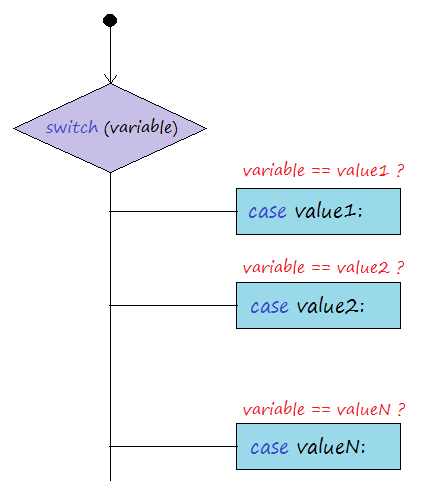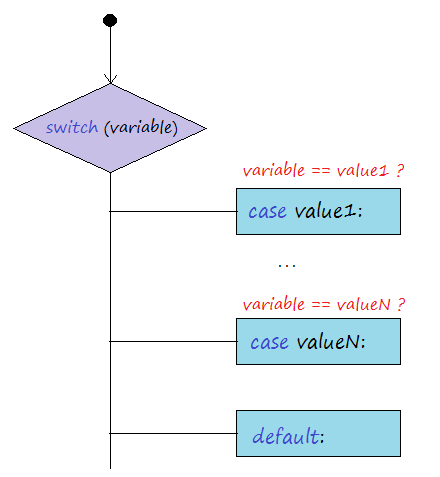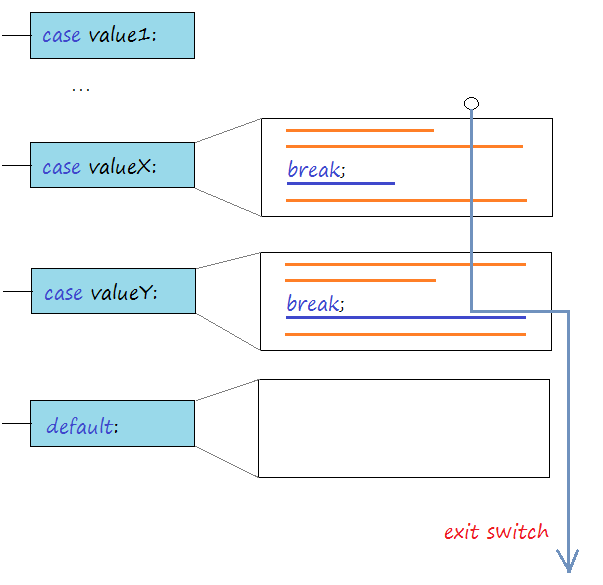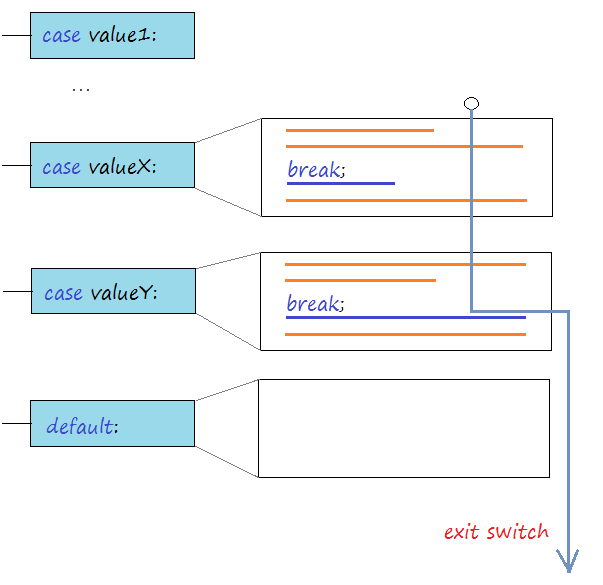Switch Statement in Java
1. Structure of switch statement
// variable_to_test: A varible to test.
switch ( variable_to_test ) {
case value1:
// Do something here ...
break;
case value2:
// Do something here ...
break;
default:
// Do something here ...
}The characteristics of switch statement:
The switch will check the value of a variable and compare that variable with each different value from top to bottom. Each value to be compared is called a case. When a case is true, the statement block of that case will be executed.

If all cases are false, the default statement block will be executed. Note: in the structure of the switch statement, there is probably or not a default statement block.

When finding a true case, the statement block of such case will be executed. If not meeting the break statement in this block, the program will continue performing the blocks below until it meets the break statement or no statement block is executed.
The break statement makes the program exit the switch. (See the illustration below).
The break statement makes the program exit the switch. (See the illustration below).

Note that the case statement is a specific value you can not do the following:
// This is not allowed !!
case (age < 18) :
// case only accept a specific value, eg:
case 18:
// Do something here ..
break;2. switch Example
SwitchExample1.java
package org.o7planning.tutorial.javabasic.controlflow;
public class SwitchExample1 {
public static void main(String[] args) {
// Declare a variable age
int age = 20;
// Check the value of age
switch (age) {
// Case age = 18
case 18:
System.out.println("You are 18 year old");
break;
// Case age = 20
case 20:
System.out.println("You are 20 year old");
break;
// Remaining cases
default:
System.out.println("You are not 18 or 20 year old");
}
}
}The results of running the SwitchExample1 class:
You are 20 year old3. break statement in switch
break means a statement to be able to appear in the case block, or default block of switch. When meeting the break statement, the program will exit the switch.

When the program meets a switch statement, it will check cases from top to bottom. When finding a true case, the block of that case will be executed. If it doesn't meet the break statement in this block, it will continue to execute the blocks below until it meets the break statement or there is no longer block to execute.
Example:
SwitchExample2.java
package org.o7planning.tutorial.javabasic.controlflow;
public class SwitchExample2 {
public static void main(String[] args) {
// Declare a variable age.
int age = 30;
// Check the value of age.
switch (age) {
// Case age = 18
case 18:
System.out.println("You are 18 year old");
break;
// Case age in 20, 30, 40
case 20:
case 30:
case 40:
System.out.println("You are " + age);
break;
// Remaining case:
default:
System.out.println("Other age");
}
}
}The results run:
You are 30Java Basic
- What is needed to get started with Java?
- History of Java and the difference between Oracle JDK and OpenJDK
- Install Java on Windows
- Install Java on Ubuntu
- Install OpenJDK on Ubuntu
- Install Eclipse
- Install Eclipse on Ubuntu
- Configuring Eclipse to use the JDK instead of JRE
- Quick Learning Java for beginners
- History of bits and bytes in computer science
- Data Types in java
- Bitwise Operations
- if else statement in java
- Switch Statement in Java
- Loops in Java
- Arrays in Java
- JDK Javadoc in CHM format
- Inheritance and polymorphism in Java
- Abstract class and Interface in Java
- Access modifiers in Java
- Java Enums Tutorial with Examples
- Java Annotations Tutorial with Examples
- Customize java compiler processing your Annotation (Annotation Processing Tool)
- Comparing and Sorting in Java
- Java String, StringBuffer and StringBuilder Tutorial with Examples
- Java String.format() and printf() methods
- Java Exception Handling Tutorial with Examples
- Java Generics Tutorial with Examples
- Understanding Java System.identityHashCode, Object.hashCode and Object.equals
- Java WeakReference Tutorial with Examples
- Java SoftReference Tutorial with Examples
- Java PhantomReference Tutorial with Examples
- Manipulating files and directories in Java
- Syntax and new features in Java 8
- Java Regular Expressions Tutorial with Examples
- Java Multithreading Programming Tutorial with Examples
- JDBC Driver Libraries for different types of database in Java
- Java JDBC Tutorial with Examples
- Get the values of the columns automatically increment when Insert a record using JDBC
- Java Compression and Decompression Tutorial with Examples
- Java Reflection Tutorial with Examples
- Java remote method invocation - Java RMI Tutorial with Examples
- Java Socket Programming Tutorial with Examples
- Java Stream Tutorial with Examples
- Java Functional Interface Tutorial with Examples
- Java Predicate Tutorial with Examples
- Java BiPredicate Tutorial with Examples
- Java Consumer Tutorial with Examples
- Java BiConsumer Tutorial with Examples
- Java Supplier Tutorial with Examples
- Java Function Tutorial with Examples
- Java BiFunction Tutorial with Examples
- Java Aspect Oriented Programming with AspectJ (AOP)
- Java Programming for team using Eclipse and SVN
- Which Platform Should You Choose for Developing Java Desktop Applications?
- Example of Java encoding and decoding using Apache Base64
- Java Commons IO Tutorial with Examples
- Java Commons Email Tutorial with Examples
- Java Commons Logging Tutorial with Examples
- Introduction to the Raspberry Pi
Show More
- Java Servlet/Jsp Tutorials
- Java Collections Framework Tutorials
- Java API for HTML & XML
- Java IO Tutorials
- Java Date Time Tutorials
- Spring Boot Tutorials
- Maven Tutorials
- Gradle Tutorials
- Java Web Services Tutorials
- Java SWT Tutorials
- JavaFX Tutorials
- Java Oracle ADF Tutorials
- Struts2 Framework Tutorials
- Spring Cloud Tutorials